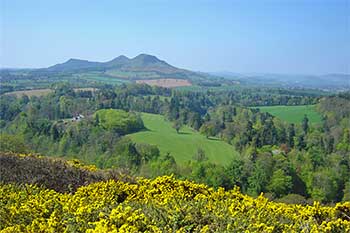
The landscape of the Scottish Borders varies from west to east. The western part has rolling hills and beautiful lochs such as St Marys Loch, one of the most beautiful lochs in Scotland according to the author. The central part of the Borders has a more rural character while the eastern part, bordering the North Sea, has some hidden gems such as the seaside village of St Abbs and the former fishing village of Cove. The river Tweed crosses the entire area of the Borders starting at the south-east at Tweed’s Well and flowing gradually to the east where the river flows into the North Sea at Berwick upon Tweed. On the banks of this beautiful river you can find lovely and romantic villages such as Peebles, Innerleithen and Melrose.
The Scottish Borders are steeped in history as it was once the home of Christian monks who lived in the magnificent Border Abbeys of Dryburgh, Melrose, Kelso and Jedburgh in the 13th and 14th centuries. Later the Borders were the scene of a devastating battle at Flodden Field but it was also the home of one of the most famous Scottish writer, Sir Walter Scott. It’s a fascinating area for those who love history but also for people who like to walk, cycle and discover the many different faces of this pretty part of Scotland.
Scottish Borders on the Map
Village and Towns in the Scottish Borders
Galashiels
The nearest town to Abbotsford is Galashiels; the largest settlement in the area. In the area to the west of ‘Gala’, as it’s known locally, are the remnants of Iron-Age earthworks and forts, especially at Torwoodlee; and it’s a reminder of the links the whole area has to the time period. More recently, Galashiels was home to a thriving textile industry, which like most of the order border towns has gone by the wayside (although Herriot Watt University’s School of Textiles is based here). The border hills have long been famed for their sheep, and the fast flowing Gala Water gave the mills the power they needed. You can still see the old factories here and there is a small museum charting the town’s history at Old Gala house.
Melrose
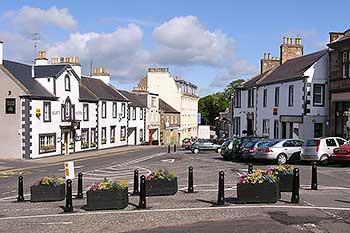 A couple of miles down the river is Melrose; Galashiels’ symbiotic twin. Apart from a love of rugby (it was here the famous ‘Sevens’ game was invented) there is little in common between the towns, and to visitors they are chalk and cheese. Where Galashiels is post-industrial and very much a commercial-service town; Melrose has charm and a sense of history about it; and thus more popular. The narrow streets and wide square are typical of a quaint Borders market town, and the old abbey is one of the best examples in Scotland (albeit that it’s ruined). Old Melrose was actually a couple of miles away in a loop of the Tweed, and it was here in the 7th century the venerable St Cuthbert lived and prayed before taking charge of Lindisfarne and Durham.
A couple of miles down the river is Melrose; Galashiels’ symbiotic twin. Apart from a love of rugby (it was here the famous ‘Sevens’ game was invented) there is little in common between the towns, and to visitors they are chalk and cheese. Where Galashiels is post-industrial and very much a commercial-service town; Melrose has charm and a sense of history about it; and thus more popular. The narrow streets and wide square are typical of a quaint Borders market town, and the old abbey is one of the best examples in Scotland (albeit that it’s ruined). Old Melrose was actually a couple of miles away in a loop of the Tweed, and it was here in the 7th century the venerable St Cuthbert lived and prayed before taking charge of Lindisfarne and Durham.
The remnants of Melrose Abbey, which was founded in 1136 and run by the Cistercian order, are to be found just beyond the main car park; but, if you continue along the road you come to a very pleasant spot on the river with an old footbridge – if picnics are your thing this is the place. The abbey is worth the visit, but it begs the question: why are there so many in this area? Well, if the king couldn’t trust his nobles to fight for him (border lords were unreliable), then better get the church onside by building and financing a load of monasteries. Most important centres in the borders have an abbey for this reason. Religion may however have played a role here going back to the prehistoric.
Kelso
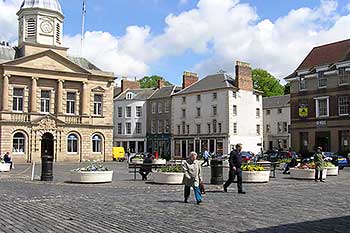 The lower Tweed Valley has one town of note, Kelso, a busy agricultural centre distinguished by the Georgian elegance of its main square and its proximity to a pair of stately homes. Perhaps surprisingly, Kelso is often visited for its abbey, even though the ruins of the colossal twelfth century foundation, whose abbots claimed precedence over St Andrews are scant indeed. But still well worth the visit.
The lower Tweed Valley has one town of note, Kelso, a busy agricultural centre distinguished by the Georgian elegance of its main square and its proximity to a pair of stately homes. Perhaps surprisingly, Kelso is often visited for its abbey, even though the ruins of the colossal twelfth century foundation, whose abbots claimed precedence over St Andrews are scant indeed. But still well worth the visit.
Dryburgh
Across the river from Newstead is the hidden village of Dryburgh, and ruins of Dryburgh Abbey, where Scott was finally buried – his tomb is next to that of Field Marshall the Earl Haig; who was born in Edinburgh and led the British forces in the First World War. Like Melrose, Dryburgh is also ruined having fallen into disuse following the Reformation in 1560. Today it’s in the care of Historic Scotland, and pretty easy to visit as long as you have a car.
Selkirk
Selkirk was once a town famous for its woollen industry, but these mills are now just another building within Selkirk. Selkirk was once the site of the first Border Abbey, where William Wallace was declared guardian of Scotland, another well known name Sir Walter Scott was also named sheriff for over 30 years. Selkirk is well known for its yearly festival named the Common Riding where up to 500 riders on horseback ride into town, the casting of the colours then take place in the town square. The common riding dates from the battle of Flodden in 1513, where 80 men from Selkirk went to the battlefield for the king, but only one returned bearing a blood stained English flag. If you ever visit Selkirk you must try the Selkirk Bannock, a delicious fruit cake.
Great Houses, Abbeys and Castles in the Borders
The Four Border Abbeys
The Scottish Borders have some of the most beautiful ruined abbeys in the UK, you can find them in Melrose, Jedburgh, Dryburgh and in the town of Kelso. On our Border Abbeys Page you can read all about their fascinating past and present.
Bowhill House and Country Estate
The home of the Duke and Duchess of Buccleuch and Queensberry, set within the stunning Yarrow and Ettrik Valleys, is a wonderful estate to visit, from fine furnishings and paintings from the most famous painters in history, and lovely forest and rivers, Bowhill house have lots to offer for the whole family for a great day out.
Floors Castle
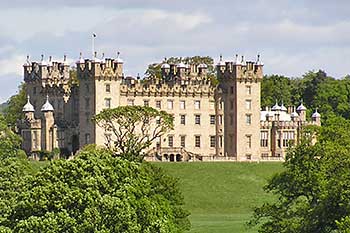 Floors Castle is the largest castle in Scotland still inhabited, and is the family home for the Duke of Roxburghe. Set by the River Tweed in the town of Kelso, the castle offers plenty to do for everyone, with fine gardens and river walks, you are sure to have a great day out at Floors Castle.
Floors Castle is the largest castle in Scotland still inhabited, and is the family home for the Duke of Roxburghe. Set by the River Tweed in the town of Kelso, the castle offers plenty to do for everyone, with fine gardens and river walks, you are sure to have a great day out at Floors Castle.
Thirlestane Castle
Thirlestane Castle is the family home of the Duke of Lauderdale and is one of the finest castles in Scotland, the castle is today inhabited by the Maitland family, and is very popular for weddings and events. Located in Lauder the castle provides lovely walks within the grounds and guided tours, also in the castle is a lovely tearoom for guests to enjoy.
Traquair House
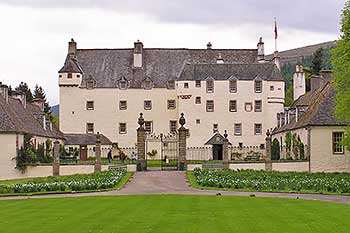 Home to the Earls of Traquair, the house is one of the finest in the Scottish Borders and Scotland as a whole, a stunning building to visit that dates back to 1107, and originally a hunting house for the royals it caters for the whole family with extensive grounds and a lovely maze. If you are lucky enough you may even choose to stay here in the Bed and Breakfast accommodation also available. A must place to visit.
Home to the Earls of Traquair, the house is one of the finest in the Scottish Borders and Scotland as a whole, a stunning building to visit that dates back to 1107, and originally a hunting house for the royals it caters for the whole family with extensive grounds and a lovely maze. If you are lucky enough you may even choose to stay here in the Bed and Breakfast accommodation also available. A must place to visit.
Abbotsford House and Sir Walter Scott
Abbotsford House
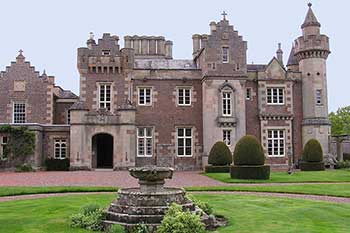 Abbotsford house is an historical building and once home to Sir Walter Scott, with a huge display of armoury including Walter Scotts own blunderbuss, the house is the ideal place to visit for anyone interested in Scottish History, also set within the grounds are stunning gardens where you will find a walled garden and lovely displays of flowers and vegetable beds.
Abbotsford house is an historical building and once home to Sir Walter Scott, with a huge display of armoury including Walter Scotts own blunderbuss, the house is the ideal place to visit for anyone interested in Scottish History, also set within the grounds are stunning gardens where you will find a walled garden and lovely displays of flowers and vegetable beds.
Sir Walter Scott
Sir Walter Scott was born in Edinburgh in 1771, the son of a solicitor, Scott survived a childhood bout of polio in 1773 that left him lame. To cure his lameness he was sent in 1773 to live in the rural Borders region at his grandparents’ farm at Sandyknowe, adjacent to the ruin of Smailholm Tower, the earlier family home. Here he was taught to read by his aunt Jenny, and learned from her the speech patterns and many of the tales and legends that characterized much of his work. Scott began studying classics at the University of Edinburgh in November 1783, at the age of only 12, a year or so younger than most of his fellow students. At the age of 25 he began dabbling in writing, translating works from German, his first publication being rhymed versions of ballads by Bürger in 1796. He then published a three-volume set of collected Scottish ballads, The Minstrelsy of the Scottish Border. This was the first sign of his interest in Scottish history from a literary standpoint. After Scott had founded a printing press, his poetry, beginning with The Lay of the Last Minstrel in 1805, brought him fame. He published other poems over the next ten years, including the popular The Lady of the Lake. Walter Scott died in 1832, aged 61, in Melrose.
Other places of interest in the Borders
The Eildon Hills
The ‘Hills of the Elves’ have since time-immemorial been sacred hills – fawned over by our Neolithic ancestors, and worshiped by our Celtic forefathers. A set of prominent volcanic peaks long since extinct, they have a peculiar conical shape which probably explains the fascination since the Stone Age. Local legend tells that they are the final resting place of Thomas the Rhymer, a 13th century poet turned prophet; who received his gift of second sight from the fairy people residing in the hills. In the Bronze Age there was a sizeable settlement on the top of the peaks, perhaps the largest hill-settlement in Scotland at the time; but, by the time the Romans arrived in the 1st century AD it was pretty much abandoned. The Romans built a signalling station on one of the peaks guarding Dere Street – their long road north from Eboracum (York).
In AD80 the Romans entered what is now southern Scotland, and set up their principal base at the foot of the Eildons on a small rise above the Tweed. The fort was called Trimontium (and may mean ‘three hills’). The local population belonged to the Votadini (Gododdin) people, a Celtic tribe that had their ‘capital’ at Traprain near Haddington; and once the Romans had consolidated their British conquests with the building of Hadrian’s Wall in the 2nd century the Votadini served as a friendly buffer state, and it is likely that Trimontium was used as a sort of embassy and trading post. The remains of the fort are to the east of Melrose at Newstead, and there is an interpretation centre that is open to the public.

St Marys Loch
Battle of Flodden Field
The region also witnessed one of the most devastating of medieval battles when the Scots under James IV, were decimated at Flodden Field in 1513. The heavily armoured Scottish noblemen got stuck in the mud at the bottom of a hill near Branxton, south of the border near Coldstream, and their over long pikes and lances were simply no match for the shorter and sturdier English halberds.
Smailholm Tower
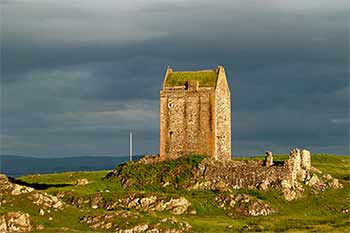 Smailholm Tower is a 20m high tower house, with walls 2.5m thick, which dominates Lady Hill and can be found some 8km west of Kelso. The tower house comprised the main residential accommodation for its Pringle laird – ground-floor cellars, first-floor hall, second-floor bedchamber and additional chambers at the top. The views from the battlements are stunning, and on a good day you can see mighty Bamburgh Castle, 53km away in Northumberland.
Smailholm Tower is a 20m high tower house, with walls 2.5m thick, which dominates Lady Hill and can be found some 8km west of Kelso. The tower house comprised the main residential accommodation for its Pringle laird – ground-floor cellars, first-floor hall, second-floor bedchamber and additional chambers at the top. The views from the battlements are stunning, and on a good day you can see mighty Bamburgh Castle, 53km away in Northumberland.
Scotts View
If you are planning a trip down to the area (about a 40 minute journey from Edinburgh), we would advise taking the back road from Earlston to Dryburgh and stopping at the beautiful ‘Scott’s View’; and its spectacular panorama over the Tweed and Eildons. It was said that Sir Walter Scott often stopped here while riding, and when his funeral cortege was heading to Dryburgh his faithful horse stopped one last time.
Views of the Scottish Borders including Scotts View and St Mary’s Loch
 Further Information:
Further Information:
- Accommodation – Hotels in Scottish Borders
- Official website – Tourist Information for the Borders
- Maps – Tourist Attractions on Google Maps
- www.traquair.co.uk – Traquair House website
- www.roxburghe.net/castle – Floors Castle
- www.scottsabbotsford.com – Abbotsford House
- thirlestanecastle.co.uk – Thirlestane Castle
- www.bowhillhouse.co.uk – Bowhill House and Estate
note on image copyright: smailholm tower Walter Baxter – licensed for reuse under this creative commons licence
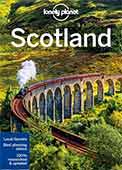
Recent Comments